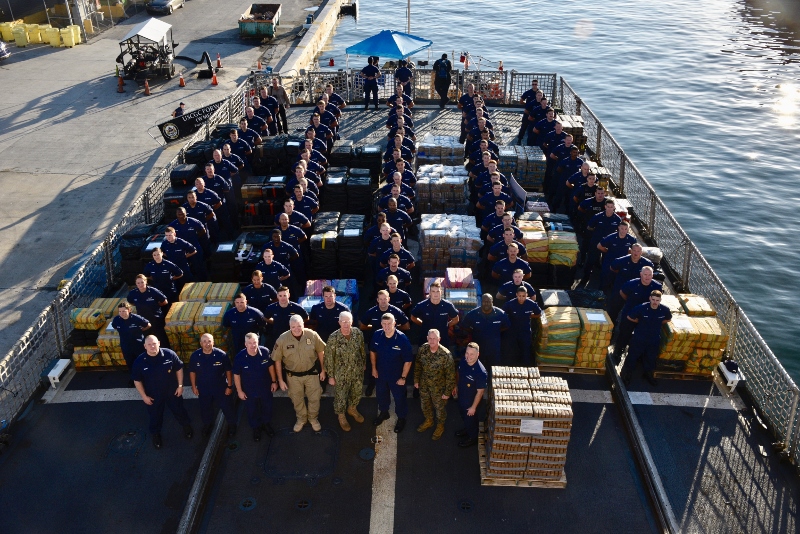Six Coast Guard cutters seized over 17 tons of cocaine worth an estimated $466 million during operations in Eastern Pacific international waters in recent months, Coast Guard officials said as the haul was offloaded Tuesday at Port Everglades, Fla.
The crew of the 270’ medium endurance cutter Forward, homeported in Portsmouth, Va., were the interception champs with eight cases capturing 14,207 lbs., and did the honors of delivering the combined seizures to port. The drug shipments were taken off the coasts of Mexico, Central and South America in 21 separate vessel interdictions by the cutters crews, working closely with the Navy, Customs and Border Protection, FBI, Drug Enforcement Administration, and Immigration and Customs Enforcement, along with allied and international partner agencies.
“The interdiction and disruption of more than 17 tons of cocaine is a result of the collaboration and coordination of multiple Coast Guard and interagency assets to address the complex maritime challenge of transnational criminal organizations,” Cmdr. Michael Sharp, commanding officer of the Forward, said in a prepared statement. “I am extremely proud of all the women and men that contributed to the mission success, it is a direct reflection of how the U.S. Coast Guard delivers mission excellence anytime, anywhere.”
The Coast Guard leads an increased U.S. and allied presence in the drug transit zones of the Eastern Pacific Ocean and Caribbean Basin. In those international waters, suspect vessels are initially located and tracked by U.S. and allied military or law enforcement, while cutter crews conduct the interceptions and boardings with fast over the horizon (OTH) boats launched from cutters. They operate under legal authority of the Coast Guard 11th District headquarters at Alameda, Calif.

Coast Guard cutter Alert boarding teams interdicted a low-profile go-fast vessel suspected of smuggling cocaine in the Eastern Pacific Ocean Jan. 4, 2019. Coast Guard photo.
During two typical cases in early January, the crew of the Alert, a 210’ medium endurance homeported in Astoria, Ore., got reconnaissance and overwatch support from Navy, CBP and Coast Guard aircrews to interdict two smuggling vessels, including a stealthy low-profile “go fast” boat rigged with three outboard engines. Seven smuggling suspects and more than 5,700 lbs. of cocaine were taken.
Commissioned in 1969, Alert is one of 14 remaining 210’ cutters built for the Coast Guard. The Reliance class are operating beyond their original service lifespan, with escalating maintenance issues and costs. The Coast Guard will phase them out with the arrival of planned 360’ offshore patrol cutters, with the first of that class now under construction at Eastern Shipbuilding Group, Panama City, Fla.
Coast Guard officials call the OPC design their “capability bridge” between the 418’ national security cutter built for high seas patrolling, and the 154’ fast response cutters serving closer to shore. The first OPC is scheduled for delivery in 2021.
“The OPC will provide the tools to effectively enforce federal laws, secure our maritime borders, disrupt transnational criminal organizations, and respond to 21st century threats,” said Coast Guard Commandant Adm. Karl Schultz. “OPCs will be the backbone of the Coast Guard’s strategy to project and maintain an offshore presence.”




